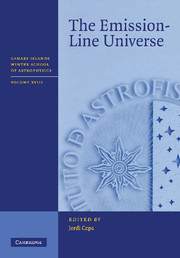Book contents
- Frontmatter
- Contents
- List of contributors
- List of participants
- Preface
- Acknowledgements
- 1 What can emission lines tell us?
- 2 The observer's perspective: Emission-line surveys
- 3 The astrophysics of early galaxy formation
- 4 Primeval galaxies
- 5 Active galactic nuclei
- 6 Chemical evolution
- 7 Galactic sources of emission lines
- 8 Narrow-band imaging
- 9 Long-slit spectroscopy
- 10 Basic principles of tunable filters
10 - Basic principles of tunable filters
Published online by Cambridge University Press: 23 November 2009
- Frontmatter
- Contents
- List of contributors
- List of participants
- Preface
- Acknowledgements
- 1 What can emission lines tell us?
- 2 The observer's perspective: Emission-line surveys
- 3 The astrophysics of early galaxy formation
- 4 Primeval galaxies
- 5 Active galactic nuclei
- 6 Chemical evolution
- 7 Galactic sources of emission lines
- 8 Narrow-band imaging
- 9 Long-slit spectroscopy
- 10 Basic principles of tunable filters
Summary
Introduction
Charles Fabry, who was born in 1867, specialized in optics and devised methods for the accurate measurement of interference effects. He worked with Alfred Pérot, during 1896–1906, on the design and uses of a device now known as the Fabry-Pérot interferometer, which was specifically designed for high-resolution spectroscopy, and is composed of two thinly silvered glass plates placed in parallel, producing interference due to multiple reflections.
In 1899 they described the Fabry-Pérot interferometer which enabled high-resolution observation of spectral features (Fabry & Pérot 1899). It was a significant improvement over the Michelson interferometer. The difference between the two lies in the fact that in the Fabry-Pérot design multiple rays of light reflected by the two plane surfaces are responsible for the creation of the observed interference patterns. The last sentence of the article reads We must emphasize the simplicity of the apparatus used and the ease with which it can be mounted at the telescope. When the silvering has been carefully selected, the interference apparatus does not cause the loss of much light and permits the study of objects of very feeble brightness.
Definition of a Fabry-Pérot interferometer
Basically, a Fabry-Pérot interferometer or etalon (from the French étalon, meaning “measuring gauge” or “standard”) is typically made of a transparent plate with two reflecting surfaces, or two parallel highly reflecting mirrors (technically the former is an etalon and the latter is an interferometer, but the terminology is often used inconsistently).
- Type
- Chapter
- Information
- The Emission-Line Universe , pp. 283 - 296Publisher: Cambridge University PressPrint publication year: 2008



